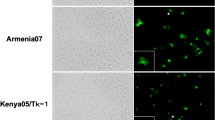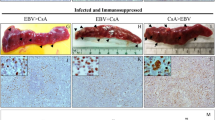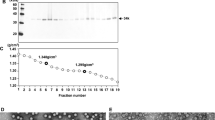Abstract
WE have been investigating the aetiology of, and the possible relationships between, leukaemia in man and domestic animals. We have shown that feline leukaemia (lymphosarcoma) is associated with a virus which has similar morphological and physical characteristics to the known leukaemogenic viruses of the fowl and mouse1,2. The virus-feline leukaemia virus (FeLV) is found in the tissues of spontaneously diseased animals3–6, and induces leukaemia in experimental cats inoculated shortly after birth5,7–9. FeLV replicates in vitro, in cells explanted from leukaemic tissues1,9,10 and in normal embryonic feline cells inoculated with cell-free extracts of tumours11. We have found that FeLV grows in human cells.
This is a preview of subscription content, access via your institution
Access options
Subscribe to this journal
Receive 51 print issues and online access
$199.00 per year
only $3.90 per issue
Buy this article
- Purchase on Springer Link
- Instant access to full article PDF
Prices may be subject to local taxes which are calculated during checkout
Similar content being viewed by others
References
Jarrett, W. F. H., Crawford, E. M., Martin, W. B., and Davie, F., Nature, 202, 576 (1964).
Jarrett, O., Laird, H. M., and Hay, D., J. Small Animal Practice (in the press, 1969).
Laird, H. M., Jarrett, W. F. H., Jarrett, J. O., and Crighton, G. W., Vet. Rec., 80, 606 (1967).
Rickard, C. G., Barr, L. M., Noronha, F., Dougherty, E., and Post, J. E., Cornell Vet., 57, 302 (1967).
Kawakami, T. G., Theilen, G. H., Dungworth, D. L., Munn, R. J., and Beall, S. G., Science, 158, 1049 (1967).
Laird, H. M., Jarrett, O., Crighton, G. W., and Jarrett, W. F. H., J. National Cancer Inst., 41, 867 (1968).
Jarrett, W. F. H., Martin, W. B., Crighton, G. W., Dalton, R. G., and Stewart, M. F., Nature, 202, 566 (1964).
Rickard, C. G., Gillespie, J. H., Lee, K. M., Noronha, F., Post, J. E., and Savage, E. L., Proc. Third Intern. Symp. Comp. Leukemia Res., Paris (1967); Bibl. Haemat., 31, 282 (Karger, Basel/New York, 1968).
Rickard, C. G., Post, J. E., Noronha, F., and Barr, L. M., J. Nat. Cancer Inst., 42, 987 (1969).
Theilen, G. H., Kawakami, T. G., Rush, J. D., and Munn, R. J., Nature, 222, 589 (1969).
Jarrett, O., Laird, H. M., Hay, D., and Crighton, G. W., Nature, 219, 521 (1968).
Drusin, L. M., Finkbeiner, J. A., McCoy, J. R., and Miller, D. G., J. Amer. Med. Assoc., 196, 99 (1966).
Viola, M., J. Amer. Med. Assoc., 205, 567 (1968).
Schneider, R., Dorn, C. R., and Klauber, M. R., J. Nat. Cancer Inst., 41, 1285 (1968).
Author information
Authors and Affiliations
Rights and permissions
About this article
Cite this article
JARRETT, O., LAIRD, H. & HAY, D. Growth of Feline Leukaemia Virus in Human Cells. Nature 224, 1208–1209 (1969). https://doi.org/10.1038/2241208a0
Received:
Revised:
Issue Date:
DOI: https://doi.org/10.1038/2241208a0
Comments
By submitting a comment you agree to abide by our Terms and Community Guidelines. If you find something abusive or that does not comply with our terms or guidelines please flag it as inappropriate.



